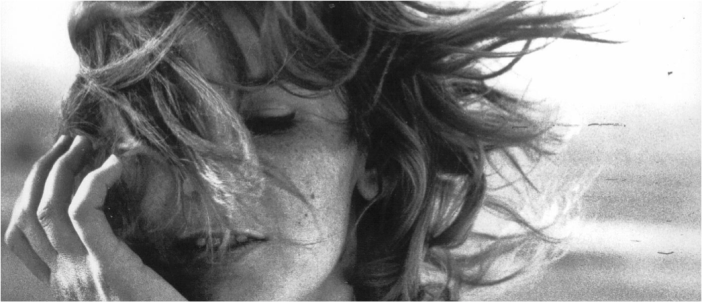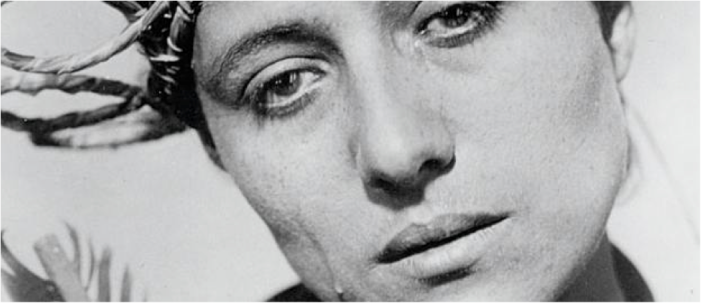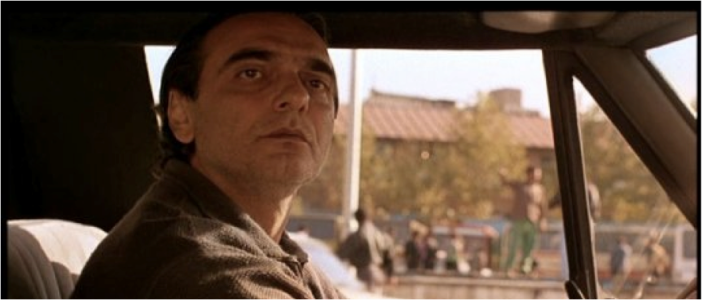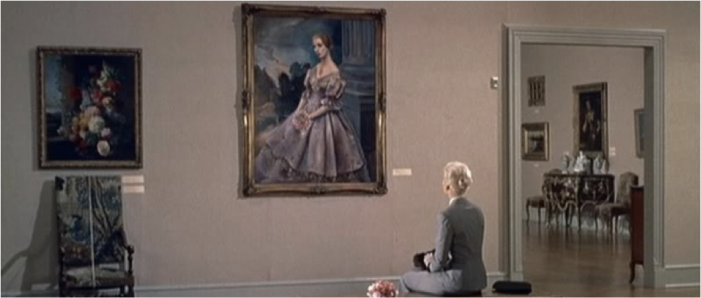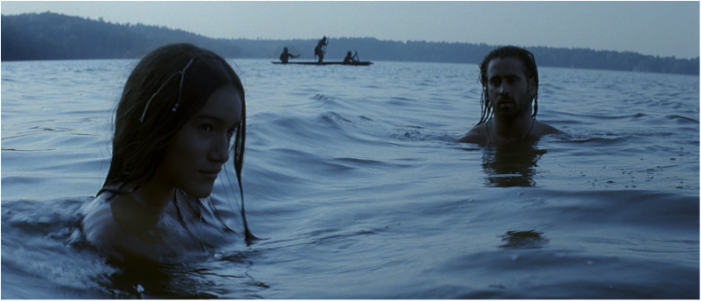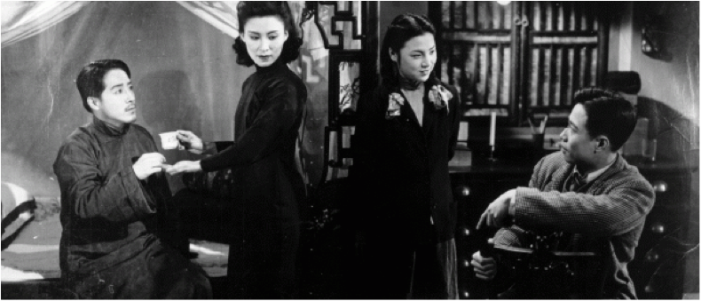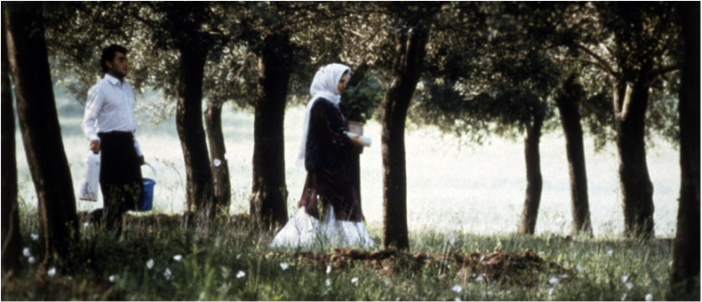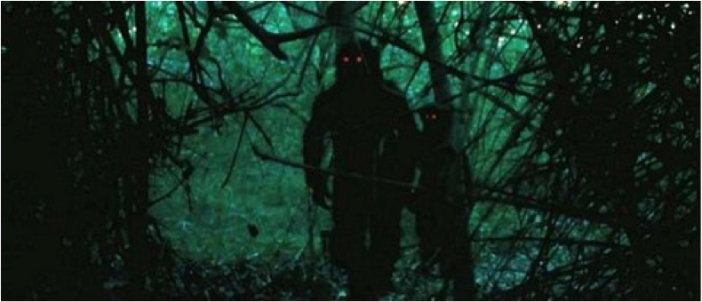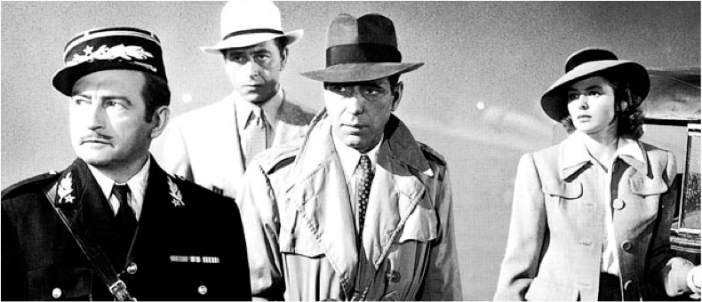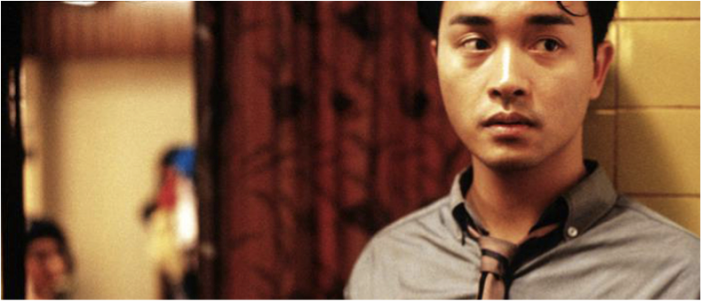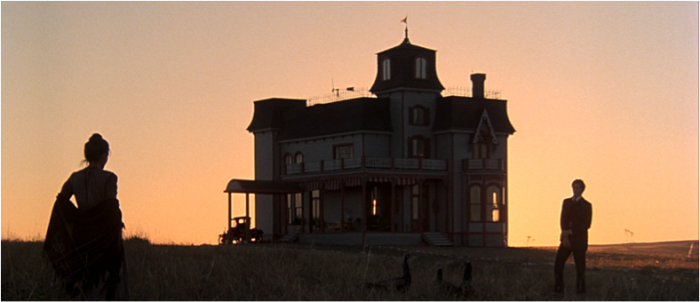
On the Five Films of Jafar Panahi Before the Ban
Since my first viewing of the radically paradigm-shifting This Is Not a Film in 2012 (my first encounter with the artist), I have become a devout Jafar Panahi evangelist. Between then and now I’ve made it my mission to get my hands on everything he’s directed, and unsurprisingly the films that comprise his small oeuvre prior to the events detailed in his above-mentioned modern masterpiece and most easily recognized film are nothing short of astonishing. And, though I too would consider This Is Not a Film his greatest work yet (its follow-up Closed Curtain a close second; still waiting to see this past year’s similarly lauded Taxi), it’s a shame that the five films leading up to Panahi’s infamous, yet unexpectedly fruitful ban from filmmaking don’t get the attention they deserve. There are those who dismiss This Is Not a Film entirely, citing its unlikely release (smuggled out of the country on a USB drive baked into a cake) as the sole reason for its welcome critical reception and elevated status over his previous efforts. And, though I strongly disagree with this borderline pretentious dismissal, I do believe This Is Not a Film and Closed Curtain are better understood and more fully appreciated in light of what came before.
From his Cannes-approved debut The White Balloon in 1995 to the boundary-pushing Offside in 2006 that ultimately pushed the Iranian government too far, Panahi’s first five films are each impressive works in their own right and together paint a compelling portrait of modern-day Tehran – at once a bustling metropolis full of life and a major urban center plagued by corruption and injustice and in need of widespread change. Whether he’s mining unexpected comedy from his subjects’ frank dialogue or depicting harsh societal realities with his neorealist-influenced style or toying with cinematic form à la Abbas Kiarostami (an inevitable comparison in any discussion of Panahi’s output), it’s clear the filmmaker is a firm believer in the power of his craft. Why else would he risk further consequences by defying his ban not once, but thrice so far? Certainly, the circumstances surrounding the director’s tragically stunted career don’t automatically create meaningful cinema, but when the art is this intelligent, challenging, and utterly captivating it’s nearly impossible to overlook Panahi’s multi-film treatise on the great city of Tehran.

The White Balloon (1995)
After directing a few short films and serving as assistant director on Kiarostami’s Through the Olive Trees, Jafar Panahi was ready to shoot his first feature length film. The White Balloon was destined to entertain comparisons to Kiarostami’s work, especially since the Iranian master helped his protégé secure funding and penned the script for Panahi’s debut. It also likely conjured memories of Kiarostami’s own recent Where Is the Friend’s Home? that put him on the map in the previous decade due to both works featuring a young child at the center with a seemingly minor conflict that sets both narratives in motion. (It’s well-known now that producing films about children helped Iranian filmmakers dodge censorship given the sheer number of restrictions on filming the interactions of adult men and women, especially in domestic settings.) And yet, from the film’s opening shot Panahi was poised to establish his own authorial voice distinct from that of his mentor.
For one, as the film opens the camera moves, fluidly, almost rapidly – something Kiarostami almost never allowed – as a concerned-looking woman (Fereshteh Sadre Orafaiy) weaves in and out of a crowd of shoppers and revelers on the eve of Nowruz (the Iranian New Year) searching for her wandering daughter. Though one may not notice upon first viewing, Panahi also introduces us to most of the supporting characters young Razieh (Aida Mohammadkhani) will cross paths with over the course of the film as they populate this scene-setting prelude. From the first moments of his first film, Panahi sets the stage for a body of work concerned with these chance encounters significant enough to alter our own individual paths no matter how briefly, thus painting a wholly realistic portrait of a world where every passerby has a story, and no one person’s story is more important than another’s. This is crucial in understanding how Panahi handles his characters. The shifting perspectives at the end of The White Balloon, early on in Offside, and most noticeably throughout The Circle may be jarring at first, but in the context of his greater canon, it reveals a remarkably generous attitude toward his fellow human being. Everyone has a story; and choosing to tell stories of those most often ignored – children, women, ethnic minorities – has defined Panahi’s pleasingly inclusive work ever since.
This is no more evident in his debut than in The White Balloon’s much-discussed finale that pushes his loose narrative into near-tragic territory to cap off an otherwise adorable tale of a relatively minor problem for two children. After Razieh and her brother Ali (Mohsen Kafili) finally convince someone to help them retrieve their money that’s fallen into a roadside gutter, the pair hurriedly vacates the frame abandoning their savior on the side of the road to purchase that coveted goldfish. Panahi’s camera, however, doesn’t leave with them. It rests on the unnamed Afghan boy (Aliasghar Smadi) who lent the siblings his rod bearing balloons for sale and purchased them chewing gum to pull the banknote from the gutter. Razieh and Ali walk back through the frame with the plump goldfish in hand and right past the balloon seller once more without an offer for repayment or even a “thank you.” Panahi’s film ends here on a final sustained freeze-frame of the boy as he picks himself up to leave with one last white balloon over his shoulder.
It’s a surprisingly ambiguous finale for a mostly straightforward film, and yet there’s unmistakably a reason behind Panahi’s audacious choice to title his film after a narratively unrelated object that stays with us through the end credits. Throughout The White Balloon, we’re captivated by this silly story of a little girl who loses a rather insignificant amount of money – a feat of bravura filmmaking to be sure. Panahi frames Razieh’s problem as a major conflict worthy of our time in his well-chosen camera angles from the eye-level of small children (positing the world as quite literally larger than life), capturing two tremendous performances from Mohammadkhani and Kafili, and infusing his narrative with a sense of urgency set in real time against a countdown to the New Year. And yet, what’s perhaps more impressive than convincing his audience to care this much is dramatically subverting our expectations when Razieh and Ali no longer deserve our sympathy.
In the film’s final shot, our allegiances shift to that of the balloon seller. When Razieh and Ali get what they want, they leave and head home for the New Year celebrations. As the flummoxed young vendor pauses before standing to leave, we’re left to ponder his circumstances. As a minority, more than likely a refugee, the boy may not have the luxury of taking a break from his work or even celebrating with family that may or may not be with him in Tehran. Is Panahi’s choice to linger on this boy’s situation a subtle form of politicizing? Raising awareness for the plight of a group of individuals most often cast aside in society? Given the number of openly political films that followed The White Balloon, it doesn’t seem that farfetched to imagine these as the director’s veiled intentions. It’s a powerful and bold statement in a political climate that rarely favors artistic freedom of expression, and one that sheds light on the wildly diverse city of Tehran.

The Mirror (1997)
For his sophomore feature The Mirror, Panahi furthers both his concern for the affairs of small children and his exploration of Iranian society through the microcosm of a few bustling streets in Tehran. The setup is remarkably simple: a young girl (Mina Mohammadkhani, notably the younger sister of the protagonist in The White Balloon) grows increasingly worried when her mother fails to pick her up after school and decides to try to find her way home on her own. In the film’s first half, Panahi once again thrills with his roving camera, unearths a profoundly sympathetic performance in his convincing lead, and widens the scope established in The White Balloon to capture fleeting, minor moments between peripheral characters that populate Panahi’s Tehran. There are compelling fragments of untold stories here – a man who offers the girl a ride who may or may not get in a motorcycle accident, a love-struck couple swapping glances separated by the gender divide on public transportation, a bitter elderly woman bemoaning the way her children treat her – as Mina bumps into various individuals on her way home.
At first, The Mirror may appear to be nothing more than a variant on Panahi’s winsome debut, but a sudden mid-film outburst from the film’s subject is sure to keep viewers on their toes. After Mina finds her way onto yet another bus that might take her in the right direction, she stares seemingly innocuously at the camera only for a voice off-screen to bluntly exclaim, “Mina don’t look at the camera!” No sooner, little Mina throws her bag down, tears off her fake cast, and declares that she no longer wishes to be in the movie. The bus stops to let her off, the film stock changes, the crew comes into view, and the audience is left completely stunned. The illusion of cinema has been gloriously shattered as Panahi and his crew hurriedly decide what to do next. When Mina stubbornly demands to leave the set and walk home herself, Panahi convinces a few members of the crew to pile into a car and follow her since she accidentally left her mike on. The film, then, takes on a dramatically different visual tone as the girl is mostly shot from a distance as cars and passersby at times obscure the camera’s view of her.
And yet, as Mina soon confesses to a passing taxi driver, she does actually need some directions getting home. Gone is the façade that her mother picks her up at school and that she’s worried about finding her way home, but essentially the film’s second half picks up right where the first half ended as Mina attempts to make her way home. Thus, Panahi posits that fiction simply mirrors reality. Panahi’s film, then, is heir to Kiarostami’s groundbreaking Close-Up, the most obvious frame of reference for The Mirror. And, as with that landmark work of blurring the ever-fine line between fiction and reality, we may never know just how much of The Mirror’s cleverly cleaved halves is real and how much is staged.
So, what then does The Mirror achieve? Is it merely Kiarostami-lite, a spellbinding deconstruction of cinematic form that pales in comparison to similarly themed works that came before? Not so fast. If Kiarostami is a filmic philosopher, one whose extreme wide shots, provocative film titles, and documentary-narrative hybrids force contemplation on grand scale questions of humanity and life, then Panahi operates in smaller spheres detailing the effects of society and life on a few. Where Close-Up’s straddling the line between reality and the illusion of reality says more about cinema than people, The Mirror walks the same line to comment on the very people who fill the screen. In one such telling sequence, Mina the performer runs into the elderly lady from the bus after she’s given up acting in the film. She sits down with her on the bench and complains about the crew’s insistence on her pouting and crying too frequently, the implication being that Mina herself would not have gotten that upset about not knowing the way home. When she asks the woman how she could put up with the filmmakers’ demands, the woman startlingly admits that she wasn’t acting. The “lines” she recited during her scenes were actual scenarios from her own life. It’s an unexpectedly poignant moment that highlights the very real circumstances of Panahi’s subjects – individuals with concerns, conflicts, and hopes of their own.

The Circle (2000)
Following the success of The White Balloon and The Mirror, Panahi treaded into deeper political waters for his third feature The Circle – arguably the greatest work of his pre-ban era. There were hints of the female perspective in his first two films – the casting of two young girls as his leads, the rather amusing yet frank discussion on the role of women in the home that takes place in the back of a cab in The Mirror, or even the character of Mina herself in The Mirror who, in the film’s second half, is fiercely independent and unafraid unlike the character she plays – but with The Circle Panahi devotes an entire film to the plight of Iranian women living in modern-day Tehran. It also marks the most substantial break from the tutelage of Kiarostami. His influence is deeply felt in both The White Balloon and The Mirror, but The Circle is the first of Panahi’s films to establish an aesthetic, tone, and subject matter firmly his own.
In fact, his bold decision to risk censorship in telling stories of the limitations that women face in Iran preempted his mentor’s similar, yet far less controversial Ten by two years. In this way, then, The Circle instead recalls the important works of Satyajit Ray and Kenji Mizoguchi who dared to tell stories of women’s hardships in India and Japan, respectively, when it was popular for neither to do so. Of course, Panahi stood to lose a lot more and did – after success on the European festival circuit, the Iranian government banned The Circle in Iran thus beginning the many issues the director would go on to face in his home country and have since defined his cinema in recent years.
The Circle, like its immediate predecessor, is aptly named after the structure of its narrative. It begins somewhat abruptly with a middle-aged woman in a hospital waiting room as her daughter gives birth inside. When a nurse appears at the window and reveals that her daughter has had a baby girl, it throws this older woman into a panic who relays to the nurse that her son-in-law’s family thought it would be a boy. What may seem like the beginning of a joke to Western viewers immediately registers as anything but when the woman verbally fears that her son-in-law may even divorce her daughter. She urges her relative to inform the rest of the family at once. As this new unnamed woman leaves the hospital and is turned down when she asks a small group of woman for change to make a phone call, she promptly exits the frame and isn’t seen again. Rather than continue the story of this “unfortunate” birth, Panahi picks up another story of the three women gathered nervously around a phone booth who we eventually learn have just escaped from prison for some unknown reason.
The rest of Panahi’s film unfolds in this way; half-told narratives of various women over the course of one evening in Tehran and the problems each of them faces. Refreshingly, there’s no contrived structure surrounding this passing off of the narrative. Panahi follows a young woman (Nargess Mamizadeh) attempting to flee the city by bus and a woman (Fereshteh Sadre Orafaiy, one of only two professional actors in the film) seeking an urgent, secretive abortion for the longest duration of the film’s runtime. But, he also lends screen time to a troubled mother (Fatemah Naghavi) who abandons her young daughter when she can no longer care for her and a prostitute (Mojgan Faramarzi) who gets picked up by the authorities while her prospective client is released with no consequences. (In the film’s best sequence, Panahi cuts back and forth between close-ups of the prostitute and a newlywed bride in the backseat of a passing car. The woman stares at the bride, but is it a look of longing or one of understanding? It’s likely no surprise that Panahi draws parallels between these two women whose circumstances may not be that different.)
Throughout, Panahi realistically sheds light on the different forms of oppression women face on a daily basis under fundamentalist Islamic rule. Women can’t smoke in public, purchase bus tickets without a male escort, rent hotel rooms alone, or receive abortions without their husband’s or husband’s father’s consent. The characters in Panahi’s film are imprisoned easily and are often ostracized from society and their families if they break any of the many, many rules set before them. One gets the impression it’s nearly impossible to breathe for women in Panahi’s Tehran. But, is it a fair portrayal? Reportedly, the Iranian government ultimately banned Panahi’s film for its unfair and resoundingly negative treatment of the nation’s women. It’s certainly a very one-sided argument; there is no other way to interpret Panahi’s film. Yet, in light of the rest of his balanced work, it’s clear that Panahi is a champion for the underdog, telling stories for those whose voices aren’t often heard. He absolutely has an agenda here, but The Circle is no mere message movie. In its clever narrative structure that brings this jaunt through an unfavorable Tehran full circle – the prostitute is locked up, and as Panahi’s camera pans around the cell the rest of the women featured so far come into view, imprisoned again as well – Panahi’s film is also an exercise in stretching cinematic form and pushing his own aesthetic forward. In retrospect, it seems to have anticipated the onslaught of unwelcome “we’re all connected” films that polluted American cinema in the decade to come. But, the narrative contrivance that brings his characters together in the end serves no other purpose than tragic metaphor (as opposed to a forced plot device) and affirms an established penchant for telling personal stories no matter how seemingly insignificant or incomplete.
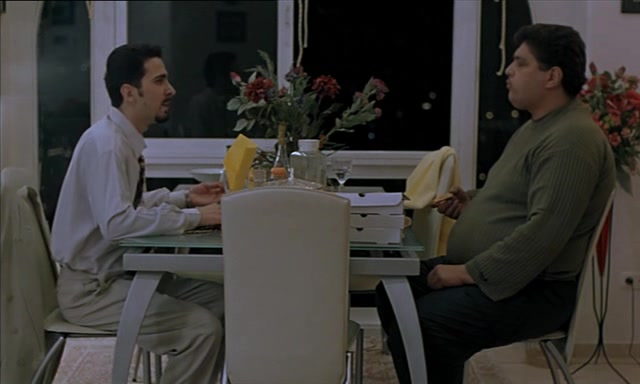
Crimson Gold (2003)
For his second collaboration with Kiarostami as screenwriter, Panahi’s Crimson Gold continues the bleaker tone set by The Circle and recounts a few days in the life of an impoverished pizza delivery man whose socioeconomic status and circumstances drive him to commit a heinous crime. This crime – the murder of a jewelry storeowner following a failed robbery attempt – opens the film; thus Crimson Gold marks the first time Panahi utilizes a flashback narrative structure in his work. In what is clearly not an act of premeditated murder, Hussein (Hossain Emadeddin) rashly pulls the trigger on himself in front of a throng of passersby who witness the killing and hurriedly call the police. Though the filmmakers’ decision to reveal the film’s outcome at the onset threatens to lessen the impact of the story that follows, the troubled life of Hussein is riveting, if not wholly convincing enough to warrant its climactic tragedy.
More than a progressive narrative, then, Panahi’s film features a series of vignettes that highlight gross income inequality in Tehran and the resultant injustice that befalls those living in poverty. The midsection of Crimson Gold, bookended by the sequence of Hussein’s murder and suicide, is made up of four major sequences, each of them realistically documenting some form of corruption or injustice within the confines of one character’s story. Over the course of the film this widespread inequality is seen as both a personal offense – when Hussein, his future brother-in-law Ali (Kamyar Sheisi), and fiancée (Azita Rayeji) are repeatedly humiliated and turned away at a high-end jewelry store or when an old acquaintance of Hussein’s awkwardly gives him a large tip when confronted with Hussein’s current, unglamorous profession – and a societal danger – when the police use a profiling tactic to arrest young passersby who may or may not be attending a raucous party in an affluent district or when the police use extreme force when arresting a man in Hussein’s poorer neighborhood.
In the film’s final episode, Panahi also manages to comment upon the blind privilege of the wealthy elite as Hussein delivers pizza to a young rich man (Pourang Nakhael) whose greatest problem appears to be as trivial as a date gone sour. Preoccupied by his own self-absorption, the man invites Hussein in to dine with him and to provide a listening ear. But, when the offending woman calls, the man leaves Hussein to himself who explores the high-rise apartment, takes advantage of its amenities, and eventually winds up on the balcony with a staggering view of the cityscape below. Up here all of Tehran is beneath this rich man who only need give the rest of the world a thought when he desires. “A city of lunatics,” he calls Tehran at one point. He refers to a culture and society that he left behind when he emigrated to the U.S. for a time, but he might as well be describing the crippling inequality that forces someone like himself and Hussein into entirely separate corners of the city.
If Crimson Gold lacks the narrative heft of Panahi’s previous work, it makes up for it with its exhilarating camerawork courtesy of DP Hossein Jafarian working with Panahi for the first time, yet propelling the director’s aesthetic forward. The camera beautifully and fluidly weaves in and out of traffic capturing stunning shots of his characters on motorbikes or subtly zooms on the entrance to the jewelry store, the shot’s only source of light, after Hussein’s murder, then graciously pans up to shield us from his gruesome suicide. Too, Panahi’s dedication to revealing unflattering sides of Tehran despite inevitable censorship is certainly commendable. He not only serves as a beacon of hopeful resistance to other filmmakers in Iran, but also to the repressed voices worldwide who are forced to create art in secret or under oppression.
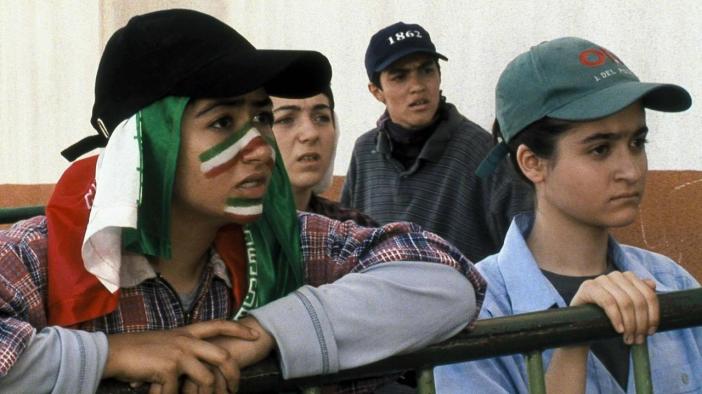
Offside (2006)
For his unknowingly final film before the ban, Panahi returned to the more light-hearted comedic feel and focus on Tehran’s youth of The White Balloon and The Mirror. And yet, Offside is no less significant because of it. It’s as politically subversive as anything in The Circle or Crimson Gold, and it pushed the Iranian government far enough to incite the charges brought against Panahi and his supposedly defamatory art that altered the future of his career a few years later. The film follows six unnamed young women who attempt to sneak into the 2005 soccer match between Iran and Bahrain that determined which team would qualify for the 2006 World Cup. To Western viewers the setup might immediately register as something farfetched until we’re clued into the fact that women are prohibited from attending public sporting events in Iran. It’s likely that even in America we still might associate football, basketball, or baseball with primarily male spectators and fans, yet no one would think twice about admitting a woman to a game. They’re just as entitled to fandom as men.
Panahi uses this most basic, widespread trait indicative of much of the world – the love of soccer (particularly outside the U.S., though our national love for American football is probably comparable) – to instill universality in his characters’ struggle. Shot as if in real time during the actual match, Panahi returns to the thrilling urgency he established in The White Balloon – that film’s countdown to New Year replaced with a ticking game clock as Iran’s shot at qualifying for the world’s biggest sporting event hangs in the balance. Though the match sets the film’s narrative in motion, it ultimately plays a supporting role in what Panahi brilliantly achieves. We never catch more than a few glimpses of the actual game as the film’s characters are held in a humiliating sectioned pen just outside the stadium guarded by three young soldiers, but Panahi is, of course, more concerned with the conversations and interactions between his characters than regaling the outcome of a soccer match.
Perhaps more than any other film in his oeuvre, Panahi impressively provides a snapshot of a larger Tehran in this huddle of characters who’d like to be anywhere but with each other. The women, of various ages and backgrounds, swiftly bond over their unbridled love of the game, a zealous dedication that both confuses and complicates their captors’ situation. Two of the three soldiers are Tehrani imports, boys from rural areas who carry their own assumptions about the city and women in general. But, ultimately, they’re won over by the girls’ unwavering enthusiasm, and in its final moments Offside erupts into joyous pandemonium as the lines that divide women and men, urbanites and ruralists, soldiers and civilians, and law keepers and law breakers fade away as they unite as fans. The girls and soldiers alike emerge from the halted van en route to the police station with sparklers in hand to join the street’s revelers in what is easily Panahi’s most satisfying finale in his entire body of work. The injustices of the society he portrays haven’t been stripped away, but he offers an unexpected ray of hope in something as seemingly insignificant, yet universally loved as soccer.
With Offside, Panahi paints his most balanced portrait of Tehran yet. If The Circle and Crimson Gold threatened to villainize anyone belonging to a privileged class – men, those in authority, the wealthy – in their appropriately despairing tones, then Offside fittingly offers a slight corrective. Panahi presents a society more or less in collective opposition to an oppressive regime. More than once do we see men trying to help smuggle disguised women into the stadium, a group of guys assists one of the girls in escaping her captors in the stadium’s bathroom yet she willingly returns after a time so as to not get the soldiers in trouble with their superiors, and in the end fans make no distinction between sex, age, race, or profession as the city rejoices in their nation’s victory. As a chronicler of the everyday lives of his fellow city dwellers, Jafar Panahi has established himself as one of the most exciting, innovative, and politically important filmmakers working today. For better or for worse Tehran is his home, and his first five films offer a captivating (albeit admittedly incomplete) picture of one of the world’s greatest cities.



